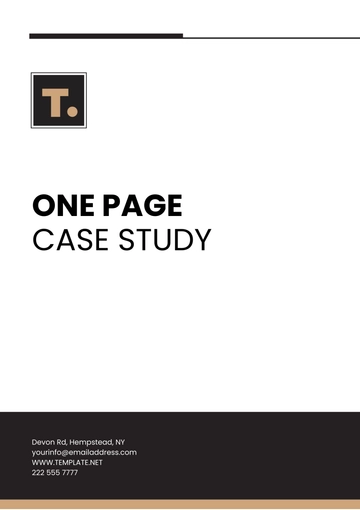Descriptive Case Study
I. Introduction
The Descriptive Case Study Template aims to provide a detailed analysis of the market expansion strategies employed by [Your Subject] in entering new international markets. This introduction sets the stage by briefly outlining the key aspects of the case and its significance in the global business landscape.
II. Problem Statement
The Problem Statement section delves deeper into the specific challenges faced within [Your Subject]'s market expansion endeavors, highlighting the need for analysis and strategic interventions.
Identification of Issues: [Your Subject] faces challenges such as cultural barriers, regulatory complexities, competitive landscapes, and market penetration strategies in new regions.
III. Methodology
The Methodology section outlines the approach and tools used to gather data, conduct analysis, and draw conclusions in the case study.
Data Collection: Primary data was collected through interviews with [Your Subject]'s key executives involved in international expansion strategies. Secondary data from market reports, industry analyses, and academic literature supplemented the primary data.
Analysis Techniques: Qualitative data from interviews was analyzed using thematic coding to identify recurring themes and challenges. Quantitative market data was analyzed using comparative analysis to assess market potentials and competitive landscapes.
Ethical Considerations: Confidentiality and anonymity of interviewees were maintained, and all data handling adhered to ethical research standards.
IV. Findings
The Findings section presents key results and insights derived from the analysis of [Your Subject]'s market expansion strategies.
V. Analysis
The Analysis section interprets the findings in the context of [Your Subject]'s objectives and challenges in international markets.
VI. Conclusions
The Conclusions section summarizes key takeaways and lessons learned from [Your Subject]'s market expansion case study.
Key Insights: Localization, strategic partnerships, regulatory compliance, and agility in adapting to market nuances emerge as critical success factors.
Implications: The findings have implications not only for [Your Subject] but also for other tech firms planning global expansions, emphasizing the importance of localized strategies and market intelligence.
VII. Recommendations
The section titled "Recommendations" in the report provides a set of concrete and actionable suggestions. These recommendations have been developed and formulated based on the deductions and conclusions that were established throughout the analysis of the case study.
Implementation Considerations: Resources for market research, cross-cultural training programs, and agile decision-making processes are crucial for the effective implementation of expansion strategies.
Case Study Templates @ Template.net






























